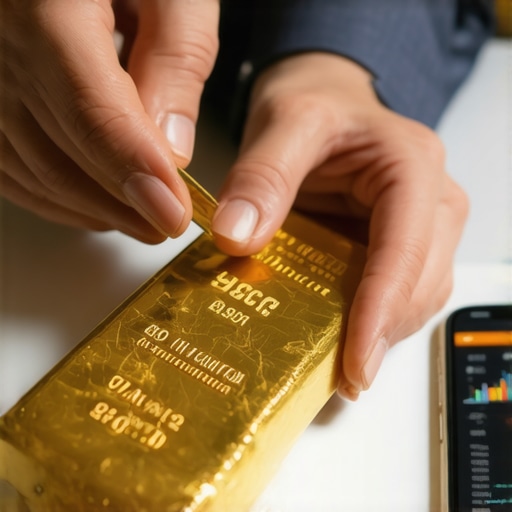Understanding the Basics of Gold Investing
Gold has long been seen as a safe haven for investors, particularly during times of economic uncertainty. For beginners looking to enter the world of gold investing, it’s essential to understand the fundamentals before diving in. This step-by-step guide aims to provide you with the knowledge you need to make informed decisions about investing in gold.
Why Invest in Gold?
Investing in gold comes with numerous advantages that can enhance your portfolio. Gold is a tangible asset, meaning it holds intrinsic value, unlike stocks or bonds which can fluctuate dramatically in value. Additionally, gold often acts as a hedge against inflation and currency devaluation, making it a popular choice among savvy investors.
Types of Gold Investments
There are several ways to invest in gold, each with its own set of benefits and considerations. You can choose to invest in:
- Physical Gold: This includes gold bars, coins, and jewelry. Investing in physical gold requires secure storage and insurance, but it provides a sense of ownership.
- Gold ETFs: Exchange-Traded Funds (ETFs) track the price of gold and can be traded like stocks. They offer convenience and liquidity without the need to physically store gold.
- Gold Mining Stocks: Investing in stocks of companies that mine gold can provide exposure to the gold market. However, these stocks are also subject to market volatility and company performance.
Researching the Gold Market
Before making any investments, it’s crucial to conduct thorough research on the gold market. Stay updated with gold price forecasts and trends that can affect your investment. Understanding the factors influencing gold prices, such as economic data, geopolitical events, and central bank policies, can help you make more informed investment decisions.
Creating a Gold Investment Strategy
Establishing a well-defined gold investment strategy is essential for success. Consider your financial goals, risk tolerance, and investment timeline. Diversifying your portfolio by including various gold investment types can help mitigate risks. For more insights on effective strategies, check out our guide on gold investment strategies.
Choosing a Reputable Dealer
If you opt for physical gold investments, it’s vital to choose a reputable dealer. Ensure they are transparent about their pricing and provide authenticity certificates for their products. Familiarize yourself with the best practices for finding gold dealers to ensure a smooth buying experience.
Staying Informed and Adapting
The gold market is ever-evolving, so staying informed is crucial. Regularly review your investment strategy and make adjustments based on market conditions and personal financial changes. For ongoing analysis, our gold market analysis post can provide valuable insights.
By following this step-by-step guide, beginners can navigate the complexities of investing in gold with confidence. With the right knowledge and strategy, you can unlock the potential benefits of gold investing in your financial portfolio.
Understanding Gold Demand Trends
To make informed decisions in gold investing, it’s crucial to understand the gold demand trends. Various factors influence the demand for gold, including economic conditions, cultural significance, and market speculation. For instance, during economic downturns, investors often flock to gold as a safe haven, driving its demand up. This behavior highlights the importance of staying updated on gold demand insights.
The Role of Central Banks in Gold Demand
Central banks play a significant role in shaping gold demand. Their purchases can impact gold prices and market perception. Increased buying by central banks generally signals confidence in gold as a long-term investment. For a deeper understanding of how central bank activities affect gold prices, refer to our analysis on central bank purchases.
Understanding Gold Price Fluctuations
Gold prices can be quite volatile, influenced by various factors including inflation rates, currency strength, and global economic stability. Staying informed about these fluctuations is essential for making sound investment choices. For a comprehensive overview of what to expect, check out our gold price forecast.
Investing in Gold: Strategies for Success
To maximize your gold investment, consider implementing various strategies tailored to your financial objectives. Whether you’re a novice investor or have experience, these strategies can enhance your approach to gold.
Diversification in Gold Investments
Diversifying your gold investments can help mitigate risks. Consider a mix of physical gold, ETFs, and mining stocks to balance potential returns. Each investment type responds differently to market changes, thus creating a more resilient portfolio. For insights on how to diversify effectively, explore our post on types of gold investments.
Long-Term vs. Short-Term Strategies
Determining your investment horizon is crucial. Long-term investors may benefit from holding physical gold or gold stocks, while short-term traders might prefer gold ETFs for liquidity. Understanding your goals will help shape your strategy. For more on trading techniques tailored to the current market, visit our guide on essential trading techniques.
Evaluating Gold Investment Risks
Every investment carries risks, and gold is no exception. It’s important to evaluate potential risks associated with your gold investments. Market volatility, geopolitical events, and changing economic conditions can all impact your investments.
Mitigating Risks Through Research
Thorough research can help mitigate risks in gold investing. Stay informed about market trends, global economic indicators, and expert analyses. Regularly updating your knowledge base can provide a competitive edge. For expert insights, refer to our gold market analysis.
Setting Realistic Expectations
Setting realistic expectations regarding returns on your gold investments is crucial. Understand that gold prices can fluctuate, and while they may increase over time, they can also experience downturns. Investors should prepare for both scenarios, ensuring they can adapt their strategies accordingly.
By incorporating these insights into your gold investment strategy, you can enhance your prospects for success. Remember to continually educate yourself and leverage available resources to navigate the complexities of the gold market effectively.
Understanding Different Types of Gold Investments
Investors often face the question of which type of gold investment best suits their financial goals. Understanding the various forms of gold investments is essential for making informed decisions. Options include physical gold, gold ETFs, and gold mining stocks. Each type has unique advantages and challenges, making it vital to evaluate them according to your risk tolerance and investment horizon. For a deeper dive into the pros and cons of these options, check out our article on comparing types of gold investments.
Physical Gold: Coins, Bars, and Bullion
Investing in physical gold remains a popular choice for many investors. Gold coins and bars serve as tangible assets that can be held in hand, providing a sense of security. However, they require careful storage and insurance. For those interested in physical gold, consider exploring our guide on understanding physical gold investments.
Gold ETFs: The Convenient Alternative
Gold Exchange Traded Funds (ETFs) offer a more convenient way to invest in gold without the hassles of physical storage. They track the price of gold and can be traded on stock exchanges. This option is particularly appealing to investors looking for liquidity and ease of management. To understand the benefits and drawbacks of gold ETFs, visit our post on understanding gold ETFs.
Advanced Gold Investment Strategies
Once you grasp the different types of gold investments, you can explore advanced strategies for maximizing your returns. These strategies encompass a variety of techniques designed to enhance your overall investment performance.
Utilizing Dollar-Cost Averaging
One effective strategy is dollar-cost averaging, which involves consistently investing a fixed amount in gold at regular intervals. This method can help mitigate the impact of market volatility and reduce the average cost per ounce over time. It’s a great way to build your gold portfolio gradually without the stress of timing the market.
Leveraging Gold Mining Stocks
In addition to direct gold investments, consider diversifying through gold mining stocks. These stocks can offer significant returns, especially during periods of rising gold prices. However, they come with their own set of risks, including operational challenges and market fluctuations. For insights into the best gold stocks to consider, refer to our article on best gold stocks.
Monitoring Global Economic Indicators
Staying informed about global economic indicators is crucial for gold investors. Factors such as inflation rates, geopolitical tensions, and currency fluctuations can substantially impact gold prices. By closely monitoring these indicators, investors can make more strategic decisions regarding their gold investments.
Inflation and Its Impact on Gold Prices
Gold is often viewed as a hedge against inflation. When inflation rises, the purchasing power of currency diminishes, driving investors towards gold as a stable store of value. Understanding the relationship between inflation and gold can help you anticipate potential market movements. For a comprehensive analysis of how inflation affects gold prices, explore our post on gold price forecasts.
Geopolitical Events and Gold Demand
Geopolitical events, such as conflicts and trade disputes, can significantly influence gold demand. During times of uncertainty, investors may flock to gold as a safe haven, driving up its price. Keeping abreast of current events and their implications for gold can enhance your investment strategy.
Strategies for Evaluating Gold Market Trends
As an investor in gold, understanding market trends is vital for optimizing your investment strategy. Evaluating gold market trends involves analyzing various factors that influence prices, including supply and demand dynamics, economic indicators, and geopolitical events. By mastering these analytical techniques, you can make informed decisions about when to buy or sell your gold investments.
Analyzing Supply and Demand Dynamics
The fundamental principle of supply and demand plays a crucial role in determining gold prices. When demand for gold increases—whether for jewelry, investment purposes, or industrial use—prices tend to rise. Conversely, an oversupply of gold can lead to price declines. To gain insights into the current supply and demand landscape, consider visiting our article on gold demand trends.
Utilizing Technical Analysis in Gold Trading
Technical analysis is a powerful tool for gold investors, allowing you to make data-driven decisions based on historical price patterns and market trends. By studying charts and indicators, such as moving averages and relative strength index (RSI), you can identify potential entry and exit points for your gold investments. For a deeper understanding of technical analysis techniques, refer to our guide on essential trading techniques.
Understanding Gold Price Forecasts
Forecasting gold prices is an integral part of successful investing. By analyzing historical data and current market trends, investors can anticipate future price movements. Various experts provide insights and predictions based on different economic scenarios, helping you navigate the complexities of the gold market.
Key Factors Influencing Gold Price Predictions
Several factors influence gold price forecasts, including inflation rates, interest rates, and currency strength. For instance, when interest rates are low, the opportunity cost of holding gold decreases, making it a more attractive investment. To explore these factors in detail, check out our article on gold price forecasts.
Expert Opinions on Future Gold Prices
Seeking expert opinions can provide valuable insights into potential future gold prices. Analysts often share their forecasts based on extensive market research and economic indicators. Staying informed about these expert analyses can help you make timely decisions regarding your gold investments.
Risk Management in Gold Investment
Investing in gold, like any other investment, comes with its risks. Therefore, implementing effective risk management strategies is essential for protecting your investment. This includes diversifying your portfolio and setting clear investment goals.
Diversifying Your Gold Investment Portfolio
Diversification is a key strategy in managing risk. By spreading your investments across different types of gold assets—such as physical gold, gold ETFs, and gold mining stocks—you can mitigate potential losses. For tips on how to effectively diversify your investments, explore our post on essential gold investment strategies.
Setting Clear Investment Goals
Defining your investment goals is crucial for maintaining focus and direction in your gold investment journey. Whether your objective is short-term gains or long-term wealth preservation, having a clear strategy will guide your decisions. For beginners, consider our comprehensive guide on investing in gold for beginners.
Frequently Asked Questions About Gold Investment
What are the benefits of investing in gold?
Investing in gold offers several benefits, including portfolio diversification, a hedge against inflation, and a safe-haven asset during economic uncertainty. Gold tends to retain its value over time, making it an attractive option for long-term investors.
How do I start investing in gold?
To start investing in gold, you can consider various options such as purchasing physical gold (jewelry, coins, or bars), investing in gold exchange-traded funds (ETFs), or exploring gold mining stocks. Each method has its own advantages and risks, so it’s essential to research and determine which aligns best with your investment goals.
What is the best time to invest in gold?
The best time to invest in gold often depends on market conditions, economic indicators, and your personal financial situation. Generally, many investors consider buying during market downturns or when gold prices are low to capitalize on potential future increases.
How does inflation affect gold prices?
Inflation typically leads to higher gold prices, as gold is seen as a store of value. When inflation rises, the purchasing power of currency declines, prompting investors to seek gold as a safeguard against devaluation. This increased demand often drives gold prices up.
What risks are associated with gold investments?
Gold investments carry several risks, including price volatility, market fluctuations, and potential storage costs for physical gold. Additionally, geopolitical events and changes in interest rates can also impact gold prices, making it crucial to stay informed and manage risks effectively.
How can I safely store physical gold?
To store physical gold safely, consider using a secure safe at home or renting a safety deposit box at a bank. It’s also essential to maintain insurance for your gold assets to protect against theft or loss.
Are gold ETFs a good investment?
Gold ETFs can be a good investment for those looking to invest in gold without the need for physical storage. They offer liquidity, ease of trading, and diversification. However, it’s important to research the specific ETF’s fees and performance history before investing.
Can gold mining stocks be considered a good investment?
Gold mining stocks can provide exposure to the gold market with the potential for higher returns compared to physical gold. However, they come with additional risks, including operational challenges and market volatility. Investors should conduct thorough research before investing in mining stocks.
Authority Resources for Gold Investment
For those seeking reliable information and resources on gold investment, consider the following trusted websites and literature:
- World Gold Council – Offers comprehensive insights into the gold market, trends, and investment strategies.
- Investopedia – Gold Investment Guide – A detailed guide covering various aspects of investing in gold.
- Kitco Metals – Provides real-time gold prices, market news, and analysis.
- BullionVault – Offers an online platform for buying and storing physical gold, along with market insights.
- Fortune Magazine – Features articles and expert opinions on investment trends, including gold.
- Morningstar – Provides research and analysis on gold ETFs and mutual funds.
Conclusion
Investing in gold can be a rewarding endeavor when approached with the right knowledge and strategies. By understanding market trends, employing effective risk management techniques, and utilizing expert resources, you can optimize your gold investment journey. Whether you’re a seasoned investor or just starting, the golden opportunity awaits you in this timeless asset. Remember, diversifying your investment portfolio and staying informed about market dynamics will empower you to navigate the complexities of the gold market successfully.











I’ve recently started exploring gold as a part of my investment portfolio after years of sticking exclusively to stocks. What really struck me from this guide is the emphasis on diversification within gold investing itself—mixing physical gold, ETFs, and mining stocks to balance risk and returns. I had always thought physical gold meant simply buying bars or coins and storing them safely, but the liquidity and convenience benefits of gold ETFs are appealing, especially for those who don’t want the hassle of storage. However, I do wonder about the trade-offs in terms of fees and authenticity guarantees between these types. Also, the role of economic factors like inflation and geopolitical events adds a lot of complexity that beginners might overlook. From your experience, how do you balance the need for research and staying current on market trends with the actual act of investing? Has anyone found a good way to stay informed without feeling overwhelmed? I’d love to hear strategies others use to create a solid, adaptable gold investment plan that suits their lifestyle and goals.